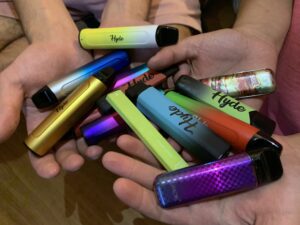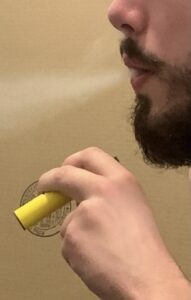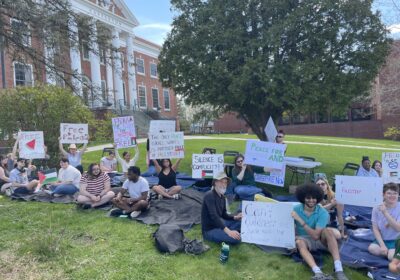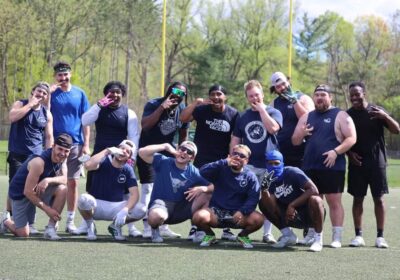Vape flavor ban sours Castleton students

It’s a Friday afternoon and a 20-year-old junior we’ll call “James,” has lost his vape.
For the third time this week.
He looked in the couch and the bed. The desk and the side table have been picked apart, too. Pillows, blankets, clothes, and everything in between are lying on the floor haphazardly –and still no nicotine to be found.
He takes one last peak in the bathroom – huffing from a full 30 minutes of fruitless searching. He peaks through the door frame, smiles, and lets a plume of smoke escape from his mouth.
“It was on the sink,” he said with a giggle.
James, who asked that his real name not be used, is one of many Castleton students who have had this experience before. Having an e-cigarette – and then periodically losing it – seems now like a rite of passage for young people, both of-age and otherwise.
On Sept. 9, the Food and Drug Administration released a statement on their year-long task of reviewing over six million “deemed” new tobacco products, many of which had already pushed their way into market. These not-quite-premarket tobacco products were reviewed based on whether they are “appropriate for the protection of the public health,” or more plainly, whether they appeal to underage smokers.
Though 4.5 million products were missing materials required for the FDA to make a decision and a total of 132 vape manufactures received “Marketing Denial Orders,” effectively removing almost one million flavored products from the market. These products include many widely popular e-cigarettes such as Puff Bars, HDQ Tech, Myle Vapes, and Ohm City Vapes. But young vapers seem undeterred by the move to remove.
Can’t stop, won’t stop
“Samuel,” a Castleton senior who also asked that his real name not be used, has had a long and complicated relationship with e-cigarette products – quitting and picking them back up for over six years now. Plastered across his room are psychedelic tapestries and marijuana memorabilia, but he says nicotine is the drug that messed with him the most.
It’s, quite literally, a toxic relationship.
He’s been using disposable products more recently because “they’re easier, and I’m lazy.” He said he’s seen the impacts of the 2019 flavor ban a little bit, but doesn’t expect this latest elimination will change his habits all that much.
“I think some smoke shops are going to comply with not selling certain vapes, but others not so much. Removing products isn’t gonna stop me from smoking, I’m just gonna spend more money and hate the government more,” he said.
And unfortunately, Samuel isn’t wrong about the number of smoke shops that comply with vaping and e-cigarette regulations. Flavor regulations are and will heavily impact the revenue of headshops, which often primarily rely on tobacco product sales.

Headshops and high schoolers
Castleton senior Adam Osha works at a headshop in Rutland and said, though his employer always cards and adheres to e-cigarette regulations, the flavor ban has them nervous about the future of their business.
“We’re constantly on the verge of worrying if we’re gonna lose our flavors – which is a huge part of our business. We’re also a glass shop, but I’d say we sell more vape products than glass and whatnot. I think it would really hurt a lot of companies and businesses – especially small businesses,” Osha said. “[E-cigarettes] are not something people mess around with, it’s not like other substances where you can just get it anywhere,”
Osha said he’s already seen the impact of flavor bans in both Massachusetts and New York, as individuals from both states come to Vermont to get their flavored products. Even he switched from Juul after flavors were removed across the country – but that’s exactly the loophole vaping regulation often faces. There will always be another product, another seller, another way to get the products people want, underage or otherwise.
Disposables have become popular in the e-cigarette business primarily for this reason and, as Osha said, “because people like to think it’s their last one.”
They’re cheap, always available, and similar enough to the once popular Juuls that underage smokers have begun using these just as commonly.
Justine Franko, a nurse at Rutland High School, said that a close student source of hers told her, “everyone uses [e-cigarettes].”
“With either nicotine or marijuana e-cigarettes, students get them online or from other students. There’s only a couple students who distribute that get them from California, but who knows where they’re being made – it could be from other countries that have no e-cigarette regulation,” Franko said.
According to the Center for Disease Control, in 2018 8.1 million U.S. adults were using e-cigarettes and 25.8 percent of these individuals were aged 18-24. More significantly, a 2019 study done by the University of Michigan found that, of over 45,000 respondents, 25.4 percent of 12th graders and 20.2 percent of 10th graders reported having used an e-cigarette within the last month. Of the college-aged students represented in this article, all but one of them began their addiction in high school.
Regulate, remove, redistribute
“Lisa” and “Steven,” Castleton senior and junior respectively who also asked that their real names not be used, sit holding hands and sharing puffs of a borrowed vape. Both casually started using Juul products in high school when it became popular among their friends. Now, after quitting on and off for several years, Lisa will occasionally pick up disposable e-cigarettes like Puff Bar or Hyde, but the two try to keep it to a few puffs at parties and nothing more.
“I think the removal of these products is just going to make young smokers turn to dangerous alternatives. Making their own vape juice, buying them from unreputable sellers, or just using fake ones instead. The government is worried that kids will die or get sick from these vapes, but the truth is, they’re still going to use them – real or not – and they’re going to have a lot more of a problem when kids start dying from shitty carts,” Lisa said.
She sits back and takes another deep inhale before setting the small, cylindrical tube back down. Within seconds, it’s in someone else’s hand. Steven squeezes her arm and she nods back with a smile, albeit a little out of breath.
“All of my friends use or have used e-cigarettes in the past, and that’s not gonna stop. People are gonna pick them up no matter what. Regulating them isn’t gonna make it harder for kids to get them, it’s just gonna make it more dangerous,” Steven said.
By the numbers
When asked the percentage of Castleton students who frequently use e-cigarettes, on average, current students said about 50%. The national average, according to the National Institute on Drug Abuse, sits around 22% of 18-to 22-year-olds.
Though limited data is available on the number of college students in Vermont who use e-cigarettes, a 2019 study known as the Youth Risk Behavior Survey concluded that a striking 50% of Vermont high schoolers have used an e-cigarette.
Even if the number of high schoolers in Vermont who vape was cut in half by the time they got to college, Vermont would still be above the national average.
Director of Public Safety Keith Molinari, a former smoker turned former e-cigarette user himself, said the switch from cigarettes to e-cigarettes on Castleton campus was apparent and rapid. He also said this transition wasn’t exclusive to Castleton – it happened everywhere.
Despite this, Molinari said he doesn’t think a large portion of Castleton students are vaping frequently, rather he “would bet it’s under five percent.”
“There is vaping going on. I wouldn’t say it’s often. I would say we get two or three incidents a year, maybe, in the residence halls. I’m sure there’s vaping on campus grounds going on that I’m not aware of, but usually if it’s in a residence hall and we get called on it, we’ll respond,” Molinari said.
Legislation or education?
Though it may never be known just how many Castleton students use e-cigarettes, it is clear that a portion will be impacted by imminent flavor bans – many are already seeing their product of choice removed from market. The question that has yet to be answered is, will there be a decrease in the number of high school students who pick up this habit after these vapes are gone?
Many students argue that, no, these vapes will still find their way to schools of both lower and higher education simply because it’s forbidden. That young adults and kids alike will feel a need to try what is not allowed, even if it’s dangerous and increasingly unreliable.
“I don’t think legislation can do much about it. I think it’s gonna be education – and even that isn’t gonna do much. I think kids that are going to do it are going do it,” Samuel said.








